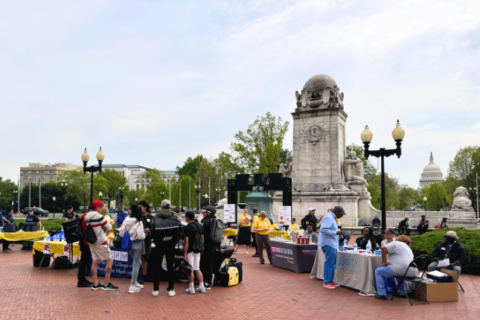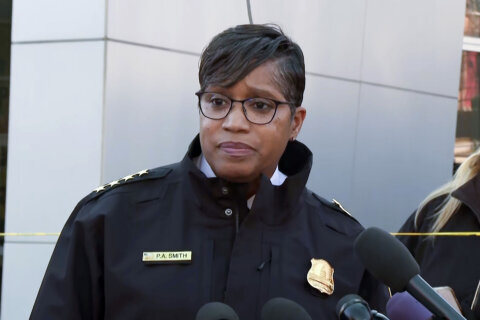For years, violent crime has been on the rise in the District.
The number of homicides so far this year already outpaces those last year by 10%, District crime data shows.
The grim statistics put 2022 on track to become the most violent year in the District in nearly two decades.
To help curb the violence, the city has begun enlisting the help of everyday people trained in one-on-one intervention with at-risk community members.
These citizens, called violence interrupters, are tasked with mitigating conflicts across 22 designated neighborhoods with high crime rates, a program overseen by D.C.’s Office of Neighborhood Safety and Engagement (ONSE).
The District is planning to add more interrupters.
But a new report by the D.C. auditor says it’s not clear if the program is working.
Violence that doesn’t happen
One of the audit’s major findings said that while ONSE collects and reports data on violence intervention activities and violent crime trends in its defined communities, “the data are too scattered and incomplete to pinpoint the program’s impact on violent crime.”
Without clear data, the audit says, there’s no way to prove that the violence interrupter’s efforts are the reason incidents of violence did not occur.
Other violent crime statistics highlighted by ONSE – like overall reductions in violent crime or decreases in assaults or thefts – don’t help to clear up the program’s effects, because they apply only to specific communities, types of crime or limited time periods.
Spread too thin
ONSE employs eight full-time and 22 part-time violence interrupters to mitigate conflict and crime in the 22 communities they serve around the city.
Such limited staffing for so many locations leaves some neighborhood sites with no full-time support, and others with very little.
The auditor found that eight priority communities were served only by a part-time interrupter, and four priority communities were served by a single full-time interrupter.
Those numbers are concerning to some anti-violence leaders and advisory neighborhood commissioners interviewed by the D.C. auditor, who called into question the ability of a single individual to create a fundamental shift in a community experiencing severe, persistent violence.
Nowhere in the District is this phenomenon more evident than in Wards 7 and 8, which experience the bulk of the city’s violent crime.
Despite this, Ward 7 has only one full-time and five part-time interrupters spread across its five priority locations. Ward 8 has no full-time violence interrupters, but instead 10 part-time staffers and one “floater,” spread across its eight priority communities.
An anonymous commissioner from Ward 7 expressed doubts that a part-time violence interrupter could affect real change in a neighborhood, telling the D.C. auditor, “This work isn’t a four-hour-a-day type of opportunity.”
And while staff are already stretched to their limits to address potentially violent conflicts in their assigned areas, Mayor Bowser expanded the program in December to add three new communities to the program - Congress Park in Ward 8, Shaw in Ward 2 and Edgewood in Ward 5.
Though full-time violence interrupters are sparse, Delbert McFadden, ONSE’s former executive director who left the agency in March, justified the deployment of staffers, saying they only focus on a small number of high-risk individuals — between five to 10 people — not the community-at-large.
And because interrupters often come from the communities where they work and have established neighborhood relationships, the audit said they can be more effective at steering high-risk community members away from violence than interrupters hired outside the community.
But the case remains for increasing the number of violence interrupters employed by the city.
For example, the number of high-risk individuals a violence interrupter engages with on a daily basis is largely dependent on their community.
“I work with the whole community — on the clock, off the clock,” one violence interrupter told the D.C. auditor, estimating that he works with 10 to 15 people per day.
Another ONSE violence interrupter who spoke to the D.C. auditor noted the great effort it takes just to get feuding groups to sit down with one another and to follow up on mediations.
The audit said that increasing the number of violence interrupters would also increase the effectiveness of ONSE’s violence intervention program, make the work environment safer for interrupters and help them to connect with people from different backgrounds.
ONSE plans to add 25 new interrupters, both full-time and part-time, with new funding it received in the city’s 2022 fiscal year budget.
Violence interventions up for debate
Mayor Bowser has widely supported violence interruption efforts in the District and used just about every resource - including more than $15 million of the city’s money - to fight rising gun violence.
But in the most recent mayoral debate, Bowser advocated for an increase in traditional policing, a pivot from her approach in December 2021 that subsidized community-based solutions.
By contrast, her opponents, Robert White and Trayon White pushed for alternatives. Robert White and Trayon White are not related.
“I’m going to expand and coordinate our violence intervention programs to meet the need of the problem,” Robert White said in the June 1 debate. “If our goal is to keep people safe, we have got to prevent more crimes.”
Just two days after the debate - on National Gun Violence Awareness Day - Bowser seemed to mimic her opponent’s support for alternative solutions by announcing the 202 for Peace initiative, which aims to stem gun violence in the District by connecting vulnerable residents to available community resources and providing a platform for victims of gun violence share their vision for peace.
And despite her debate stance, the mayor's fiscal year 2023 budget invests more than $80 million in non-police interventions, signaling Bowser’s continued support for the initiatives.
Editor's Note: WTOP reached out to ONSE and the Office of the City Administrator's Gun Violence Prevention program for comment. Neither made a representative available for comment before this story's publication.








